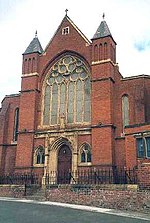Wearmouth railway station
1839 establishments in England1848 disestablishments in EnglandDisused railway stations in Tyne and WearNorth East England railway station stubsPages with no open date in Infobox station ... and 3 more
Railway stations in Great Britain closed in 1848Railway stations in Great Britain opened in 1839Use British English from May 2022
Wearmouth railway station served the area of Monkwearmouth, Tyne and Wear, England, from 1839 to 1848 on the Brandling Junction Railway.
Excerpt from the Wikipedia article Wearmouth railway station (License: CC BY-SA 3.0, Authors).Wearmouth railway station
Roker Avenue, Sunderland Monkwearmouth
Geographical coordinates (GPS) Address Nearby Places Show on map
Geographical coordinates (GPS)
| Latitude | Longitude |
|---|---|
| N 54.9159 ° | E -1.377 ° |
Address
Roker Avenue
Roker Avenue
SR6 0HQ Sunderland, Monkwearmouth
England, United Kingdom
Open on Google Maps








